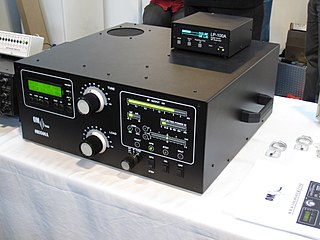Products
Transmitting tubes

Machlett was well known for its rather complete line of transmitting tubes, most particularly triodes.
For quite a while, Machlett's 6697s [2] were the most-used Class B modulator tubes (as a push-pull pair) and Class C final tubes (as a single-ended pair) in 50,000-watt plate-modulated AM transmitters.
In a classical Doherty amplifier (a Class B "carrier" tube and a Class C "peak" tube), 50,000 watts could be achieved using only two 6697s, but the drive requirement was about 5,000 watts, so the driver was often a complete 5,000-watt transmitter. The driver power could be "passed through" (i.e., was not dissipated as heat) if the carrier tube was operated with a grounded grid and, as before, the peak tube was operated with a grounded cathode. [3]
Later, chief competitor Eimac released tetrodes which rather quickly eclipsed Machlett's triodes, as tetrodes have higher gain (thereby requiring much lower driver power, usually about 1,000 watts for 50,000 watts out), and do not require "neutralization". And tetrodes can be screen-grid modulated, especially in a Sainton-modified Doherty amplifier, [4] where both the "carrier" and "peak" tubes may be operated in Class C. [5]
6697s were also employed in RCA's upgraded Ampliphase transmitter, the BTA-50H.
CPI's Econco division remanufactures Eimac and Machlett power tubes.
X-ray tubes
They were the first company to utilize the concept of the rotating anode, something which is just about universal in medical X-ray systems at this date. Towards the end of the time of manufacture, they were producing oil-circulating X-ray tubes with a heat exchanger attached (for use with computed tomography (CT) scanners), with 5-inch diameter rotating anodes formed from tungsten-rhenium alloy and molybdenum, with a large mass of graphite attached to act as a heat sink. Smaller tubes without graphite heat sinks had highly radiative coatings to disperse the generated heat into the oil surrounding the tube itself.
The manufacture of X-ray tubes was licensed to two other companies, GEC Medical and Comet SA of Bern in Switzerland.
Machlett X-ray tube
The Machlett X-ray tube was produced to ‘provide electrostatic protection for the filament (cathode) so as to permit long life to be achieved at operating voltages in the range 100-300 kV’ i . The X-ray tube was designed and manufactured by E. Machlett & Son who were specialists in scientific glass instruments. The American company, which was established in New York 1897, began as a single shop and soon grew into an internationally recognized firm. The Machlett X-ray tube was patented in April 1934; one of its tubes, at the University of Melbourne's School of Physics, is from 1937. These X-ray tubes may have been used by Professor T.H Laby's X-ray group, which was a priority research topic there. This interest was sparked by the appointment in 1889 of Professor T. R. Lyle. Lyle, who was head of the school until 1915, is thought to have been the first person in Australia to have taken an X-ray photograph iii. A photocopy of this photograph can be found in the School of Physics Archive. For this particular experiment, Lyle actually made his own x-ray tube. His successor, Laby, continued to work with X-rays. During the 1920s he worked on the X-ray spectra of atoms and in 1930 he, along with Dr C. E. Eddy, published Quantitative Analysis by X-Ray Spectroscopy iv . Also with Eddy Laby produced the paper "Sensitivity of Atomic Analysis by X-rays". Laby went on to have an X-ray spectrograph of his own design manufactured by Adam Hilger Ltd.
Accessories
As well as X-ray tubes, they manufactured collimators – to define the beam size – and three marks of “Dynalyser” – an invasive instrument for measuring all the important parameters in an X-ray tube. This consisted of an HV unit insulated with SF6, and an indicating unit. A separate radiation monitor could be used with this, and an oscilloscope could also be attached to this device if desired. Some 2,500 of the most recent version were sold, and this device survived the sale of the company to Varian and later buyers, being in production from the early 1980s to around 1995.
There were three generations of the Dynalyzer produced. Maintenance on the Dynalyzer is available by its inventor, Dr. Jon Shapiro, at http://giciman.com










